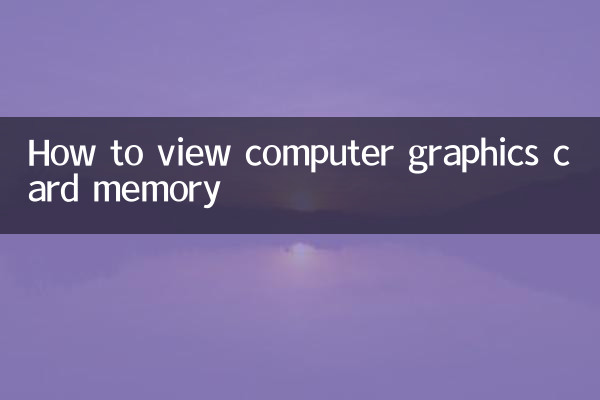How to view computer graphics card memory
With the development of technology, the performance of computer graphics cards has attracted more and more attention from users, especially the size and type of graphics card memory (video memory), which directly affects graphics processing and gaming experience. This article will introduce in detail how to view the memory of computer graphics cards and analyze the importance of graphics memory and related hot content.
1. How to view the computer graphics card memory

Here are several common ways to view computer graphics card memory:
| method | Operation steps |
|---|---|
| Settings via system | 1. Right-click the blank space on the desktop and select "Show Settings" 2. Click "Advanced Display Settings" 3. Select "Display Adapter Properties" 4. View Dedicated Video Memory in the Adapters tab |
| Using DirectX Diagnostic Tool | 1. Press Win + R, enter "dxdiag" and press Enter 2. Switch to the Display tab 3. Check the "Display Memory (VRAM)" column |
| With the help of third-party software | 1. Download and install GPU-Z or CPU-Z 2. After opening the software, check the memory size in the "Graphics" or "Graphics" tab |
2. The importance of graphics card memory
Graphics card memory (Graphics memory) is the high-speed memory used by graphics cards to store image data. Its size and type directly affect the efficiency of graphics processing. The following are the main functions of video memory:
1.Store texture and framebuffer data: Video memory is used to store texture, model and frame buffer data in games or applications. The larger the video memory, the more image data it can process.
2.Improve performance at high resolution: At high resolution (such as 4K), the demand for video memory has increased significantly, and sufficient video memory can avoid lag and frame drops.
3.Support multitasking: For tasks such as video editing and 3D rendering, large video memory can process more data at the same time, improving work efficiency.
3. Recent hot topics related to graphics card memory
In the past 10 days, the hot topics on graphics card memory across the network have mainly focused on the following aspects:
| Hot Topics | Main content |
|---|---|
| New generation graphics cards released | NVIDIA and AMD are about to release a new generation of graphics cards, with memory capacity and bandwidth becoming the focus. |
| Gaming memory demand increases | The recently released 3A masterpieces have higher requirements for video memory, and 8GB of video memory has become the entry-level standard. |
| Video memory type comparison | The performance differences between GDDR6 and GDDR6X video memory have sparked discussions, and users are paying attention to cost-effective choices. |
4. How to choose the right graphics card memory
It is very important to choose the right graphics card memory according to your needs. The following are the recommended graphics memory sizes in different scenarios:
| Use scenarios | Recommended video memory size |
|---|---|
| Daily office/web browsing | 2GB-4GB |
| 1080P Game | 6GB-8GB |
| 4K Games/Professional Design | 12GB and above |
5. Summary
Graphics card memory is one of the important indicators for measuring graphics card performance. Video memory information can be easily viewed through system tools or third-party software. As games and applications improve graphics performance requirements, it is crucial to choose a video memory size that suits your needs. Recently, discussions on the new generation of graphics cards and graphics memory technology have been very popular, and users can pay attention to relevant news in order to make smarter purchasing decisions.
Hope this article helps you better understand graphics card memory and provide reference for your computer use or upgrade!

check the details

check the details